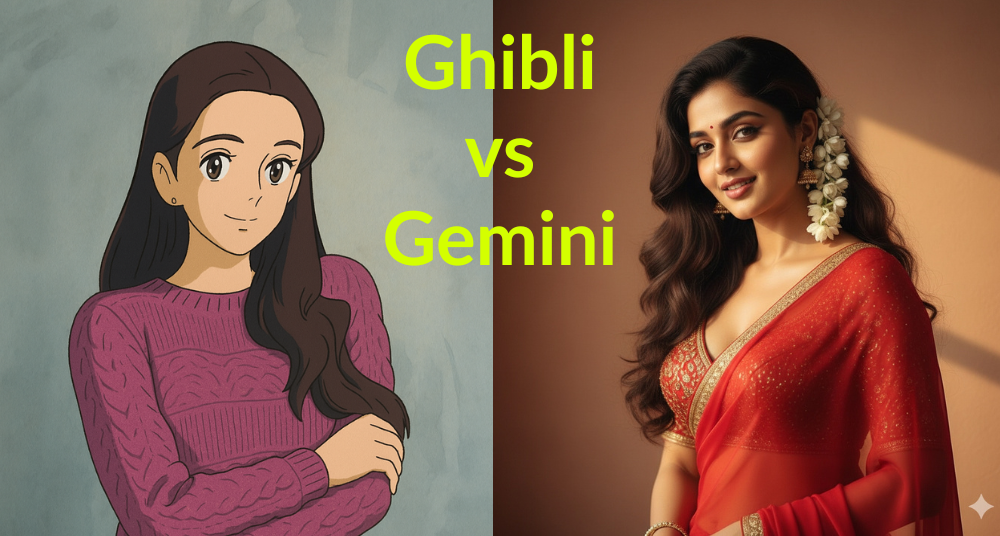In the ever-evolving landscape of social media, viral trends are the currency of digital identity. They appear in a flash, dominate our feeds, and just as quickly, recede into the vast ocean of internet history. But every so often, a trend emerges that is not just a passing fad but a milestone, a cultural touchstone that reveals something profound about our relationship with technology and art.
The “AI Art Battle for Your Feed” is a tale of two such milestones: the nostalgic, whimsical embrace of the Ghibli trend and the playful, hyper-realistic collectible craze of Gemini. These two phenomena, while both leveraging the power of artificial intelligence, represent a fundamental shift in user desire and technological capability. One was about escaping into a serene, hand-drawn fantasy; the other is about creating a hyper-personal, tangible-looking version of reality. This is not just a style clash—it’s a battle between two different visions of the future of digital self-expression.
The Ghibli Trend: A Nostalgic Escape into Hand-Drawn Dreams
The Ghibli AI trend was an ethereal and gentle wave that washed over social media platforms. Its aesthetic was instantly recognizable: a soft, hand-drawn look with painterly textures, a muted yet warm color palette, and often, a peaceful, rural or fantasy setting. This style was a direct homage to the beloved works of Studio Ghibli, the Japanese animation studio renowned for classics like Spirited Away, My Neighbor Totoro, and Princess Mononoke.
Why It Resonated:
The Ghibli trend’s appeal was deeply emotional and nostalgic. In a world of increasing digital noise and high-definition realism, the filter offered a retreat. It allowed users to transform their mundane reality—a selfie in a living room, a picture of a pet—into a scene straight out of a whimsical anime film. The style evoked a sense of comfort, innocence, and wonder, tapping into a collective love for Ghibli’s themes of nature, human connection, and simple, profound beauty. It wasn’t about looking “better” or more realistic; it was about looking different, about becoming a character in a peaceful story.
The Technology Behind the Charm:
Technologically, the Ghibli trend was primarily a form of style transfer. These AI models were trained on thousands of images from the Ghibli universe, learning to replicate the distinct brushstrokes, color gradients, and character outlines. When a user uploaded their photo, the AI would apply these learned styles, effectively “painting” the user’s likeness in the Ghibli aesthetic. While a remarkable feat, the models were often a single-purpose tool, a stylistic filter that could be applied with a single click. The end product was beautiful, but it was a stylistic transformation rather than a fundamental recreation.
The Gemini Trend: The Rise of Hyper-Realistic Collectibles
If the Ghibli trend was a soft, watercolor painting, the Gemini trend is a gleaming, high-fidelity 3D model. Known colloquially on social media as the “Nano Banana” model, the Gemini 2.5 Flash Image tool burst onto the scene with a completely different objective: to turn people and pets into incredibly detailed, toy-like figurines.
The Nano Banana Effect:
The nickname “Nano Banana” aptly captures the trend’s playful, almost absurd charm. Users would upload a photo of themselves, and in an instant, the AI would render a 3D-like, plastic figurine complete with realistic reflections, a simulated display base, and even a “toy box” backdrop. The results were startlingly realistic, with the figures looking as if they were mass-produced collectibles you could find in a toy store.
Why It’s a Game-Changer:
The Gemini trend’s appeal lies in its novelty and its direct engagement with the modern consumer culture of collectibles and personalized goods. It taps into a desire not just to see oneself in a new light, but to own a unique, digital “toy” of oneself. The hyper-realism is a key part of the appeal; it feels more tangible and unique than a simple filtered image. It’s less about fantasy and more about a new form of digital personalization, a playful nod to pop culture.
The Technological Leap Forward:
The Gemini trend represents a significant advancement in consumer-facing AI. Unlike the Ghibli style transfer, the Gemini model demonstrates a more complex understanding of 3D space, lighting, and texture. It is not just overlaying a style; it is reconstructing a subject into a new, complex form. The model is capable of something called “character consistency,” a major challenge for earlier AI models. This means it can maintain the likeness of a person across different prompts and scenarios, a capability that allows for a more versatile and personalized creative experience. This is what enables users to create a series of their “figurine” in different poses and settings, cementing the idea of a personal, digital collectible.
The Battle: Comparing Two Giants of the AI Art World
The “battle” between Ghibli and Gemini is not a competition of superiority, but a demonstration of two different facets of AI’s potential and our collective digital psyche.
| Feature | Ghibli Trend | Gemini (Nano Banana) Trend |
| Aesthetic | Nostalgic, hand-drawn, 2D | Hyper-realistic, 3D-rendered, tactile |
| Emotional Appeal | Escapism, whimsy, comfort, nostalgia | Playfulness, novelty, personalization, ownership |
| Technological Approach | Style transfer, single-purpose filter | Sophisticated generative model, 3D rendering |
| Underlying Motivation | To become a character in a dreamlike world | To create a unique, collectible version of oneself |
| Art Form Analogy | A watercolor painting or animated sketch | A high-end vinyl toy or collectible figurine |
From Fantasy to Tangibility:
The most significant difference lies in the end goal. Ghibli was about a beautiful escape from reality. It promised to take your image and place it in a serene, fictional world. The Gemini trend, however, is about bringing a fictional aesthetic into our reality. It takes a digital image and gives it the appearance of a physical, tangible object. This shift from escapism to a playful form of digital “ownership” is a major cultural pivot.
From Filter to Tool:
The technological shift is equally important. The Ghibli filters were often a closed-box solution—you fed in a photo and got a styled output. The Gemini model, while still a simplified consumer tool, hints at the power of more sophisticated generative AI that can understand and manipulate objects in three-dimensional space. This opens the door to a new wave of interactive and highly personalized content creation. The “Nano Banana” name isn’t just a gimmick; it signifies a model capable of generating tangible-looking results that were previously the domain of professional 3D artists.
The Latest Ongoing Trend and What It Means for Us
The Gemini trend is not just the “latest ongoing trend”; it represents the next step in the consumerization of complex generative AI. It demonstrates a move towards:
- Increased Personalization: Users are no longer content with simply applying a generic filter. They want to create something unique to them, something that feels like an expression of their individual identity.
- The Gamification of Self-Expression: The joy of creating a “figurine” of oneself is akin to playing a game or collecting a digital asset. It’s a fun, low-stakes way to engage with technology and show off the results.
- The Blurring of Lines Between Digital and Physical: The hyper-realistic look of the Gemini figurines makes them feel more “real,” blurring the line between a digital creation and a physical object. This trend suggests a future where our digital identities will increasingly have a tangible, almost collectible quality.
Conclusion: The Future is a Hybrid
The battle between Ghibli and Gemini isn’t about a winner and a loser. It is a chronicle of two different human desires fulfilled by AI. The Ghibli trend answered our need for beauty and escape, a gentle retreat from the real world. The Gemini trend answers our modern desire for personalization, playful realism, and a unique digital footprint.
Looking ahead, the future of AI art trends will likely be a hybrid of these two forces. We might see tools that combine the dreamlike qualities of Ghibli with the hyper-realistic, customizable nature of Gemini. We may see an AI that can turn a hand-drawn sketch of a character into a fully rendered, textured, 3D collectible.
Ultimately, these trends are more than just momentary digital fads. They are a mirror reflecting our changing relationship with technology. They show us that AI isn’t just a tool for productivity or information retrieval; it’s a new, powerful medium for human creativity, allowing us to be both the artist and the muse in our own digital story. The Ghibli trend was the beautiful prologue, and the Gemini trend is a bold new chapter. What comes next will be defined by what we, as users, ask AI to help us create.
Related Blog: Google Gemini Photo Editing Prompt






What do you think?
It is nice to know your opinion. Leave a comment.